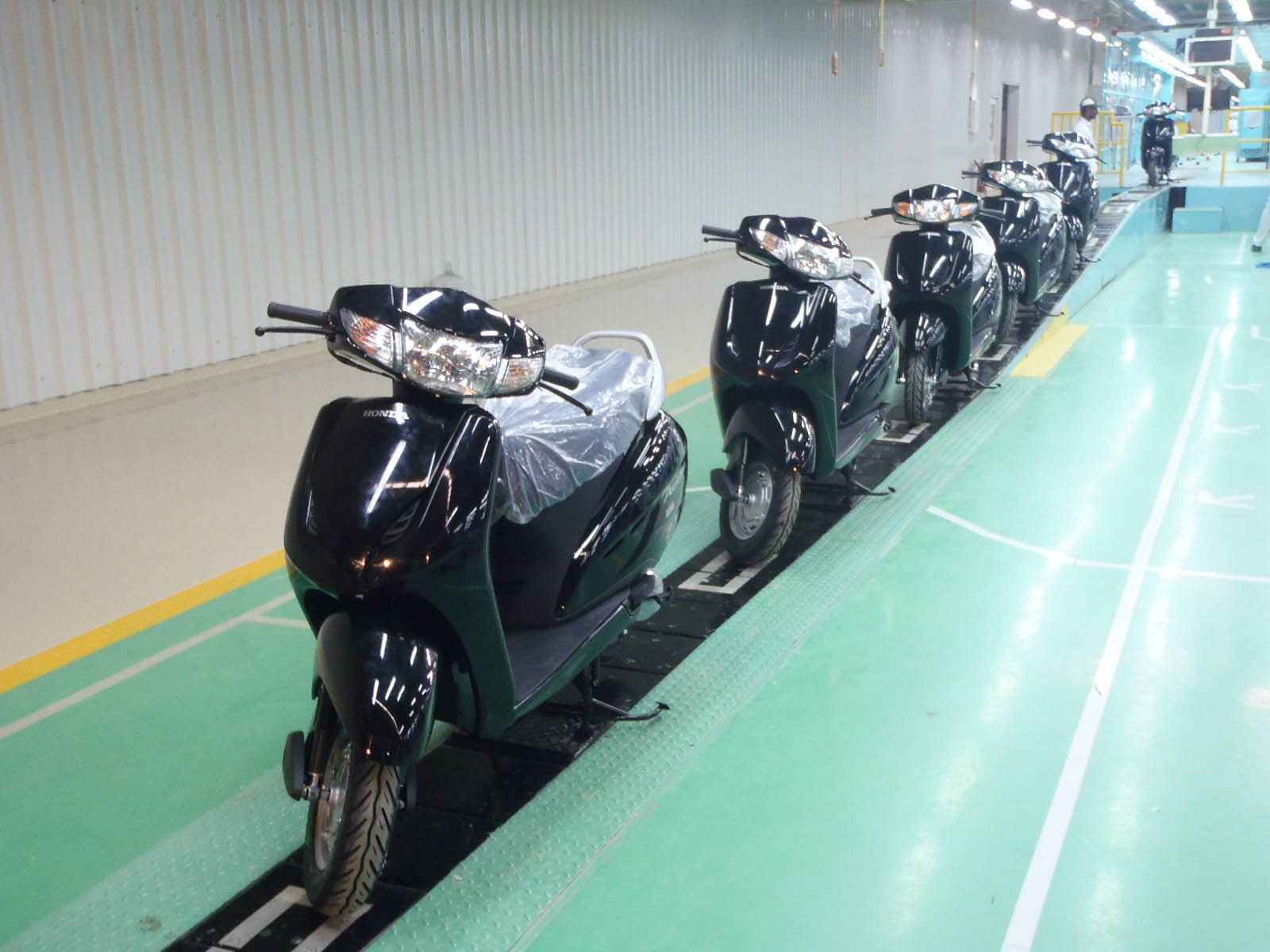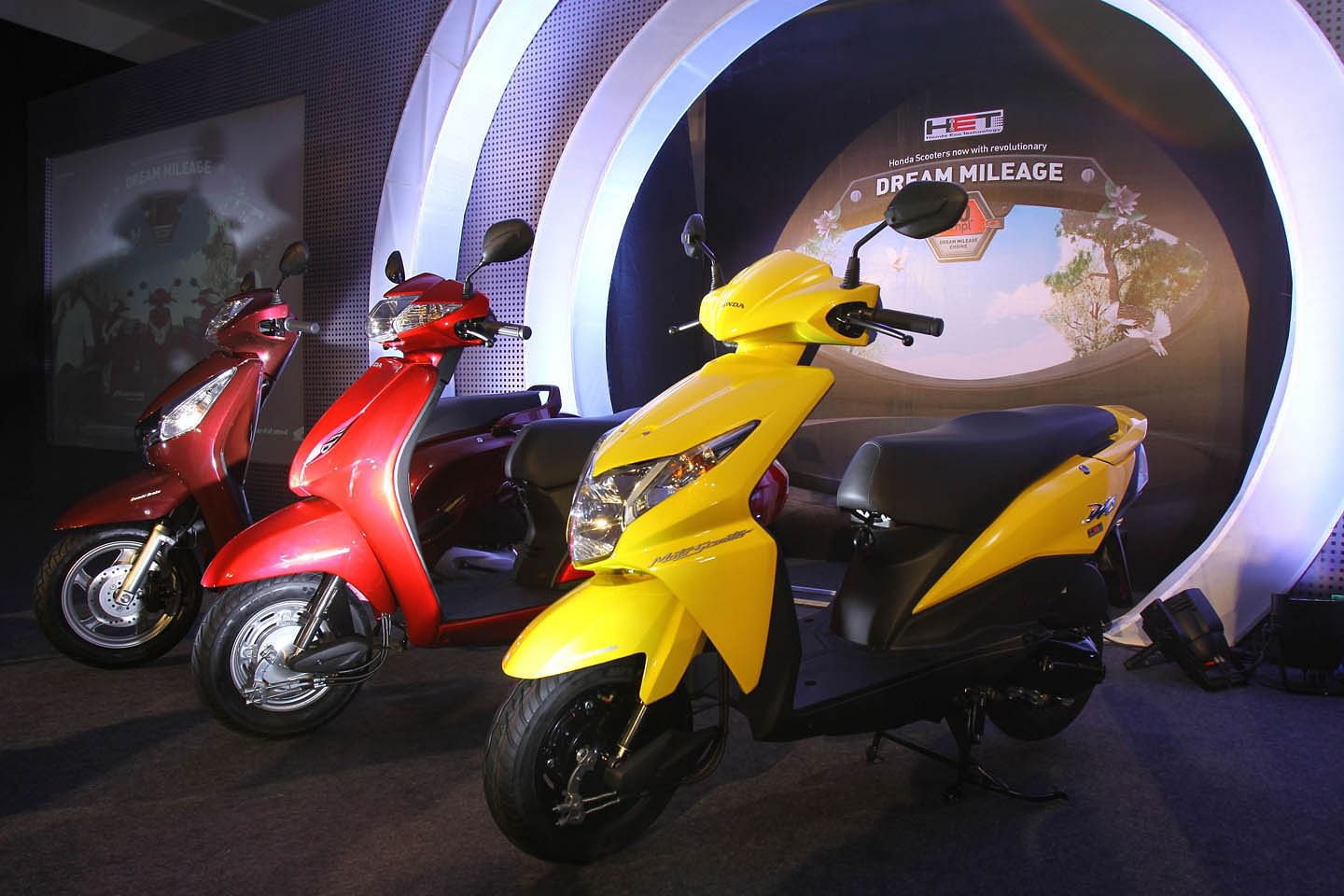'Nearly 75,000 female buyers join the Honda Activa family each month.'
The Honda Activa recently crossed the 10 million sales landmark in India. Y S Guleria, senior VP (sales & marketing), Honda Motorcycle & Scooter India, speaks to Amit Panday on the scooter that has initiated a revolution.
The Honda Activa recently crossed the 10 million sales landmark in India. Y S Guleria, senior vice-president, sales & marketing, Honda Motorcycle & Scooter India, speaks to Amit Panday on how this model alone has ushered in a scooter revolution in the country.
What in your opinion led to the Activa driving scooterisation in India? What is the secret to the Activa’s success in India?
When Honda entered India (as a 100 percent subsidiary of Honda Motor Company, Japan) in 1999, our existing agreement with another company (Hero MotoCorp) had it that we were supposed to sell only scooters for the first three years, from the start of our commercial production from 2001 to 2003. Obviously, we had a choice of having a geared or an automatic scooter.
Seeing the new lifestyle of an emerging India, Honda engineers and the service and marketing teams decided to place their bet on automatic rather than on geared scooters. This, when the market for geared scooters was falling along with automatic scooters.
However, there was hope since automatic scooters were only two-stroke then. With Honda being globally renowned for its four-stroke technology, we decided that we must come up with automatic scooters with four-stroke technology.
Once we had chosen the automatic scooter route for India, it became very important that while finalising the design, it must have universal appeal rather than a specific segment (males and females) to drive volumes in the long run. That’s why the unisex design was chosen to appeal to both – males as well as potential female buyers.
The percentage of female buyers (two-wheelers) was not as significant as it is today. Any investment should be made with long-term vision. We did so also keeping in mind the utility for Indian families – if there is an automatic scooter with unisex appeal, all family members, including the elderly, can ride it. Also, an automatic scooter offered the convenience of not having to change gears in traffic.
The Indian customer always keeps durability as one key parameter while making a purchase decision and that’s why the metal body for automatic scooter choice was decided.
It was also the first scooter that came with the Tuff-Up tube feature, a major reason for the Activa getting acceptability beyond city limits. The Tuff-Up tube enabled riders to ride to the nearest puncture shop for repair, without having to bear the inconvenience of dragging the scooter.
So a complete package of four-stroke technology (hence more mileage), comfort and convenience of automatic gears, unisex design and durability via metal body was finalised initially for our first scooter product concept, and all other things began falling in place. Finally, we saw the product in the shape of an Activa, which appealed to buyers universally and easily found liking across Indian families. The rest, as we know, is history.
In 2001, there was a large base of traditional riders with a do-it-yourself approach. They would like to clean up their scooters and even carry out frequent maintenance like setting up the carburettor and fine-tune other areas on their own. For them, we developed the CLIC mechanism – a convenient Lift Up Independent Cover on the Activa – which enabled the user to open the body of the scooter, just like the bonnet of the car.
Were Honda dealers under pressure to deliver then?
We cannot give all the credibility to the product alone. While that obviously was core to the success, our dealership network was equally important in making the Activa a big success. We wanted business partners who believed in brand Honda because initially we were supposed to sell only scooters, which were less than 10 percent of the total two-wheelers sold in India in 2000-2001.
Who would like to join hands with you, especially when you do not have a product for the next three years that will cater to the larger part of the industry volume? Ninety percent of the industry was not available for us to compete in at that point in time.
Our dealers believed in us and agreed to sell only one product – the Activa – from the beginning. They poured in their hearts and souls in serving customers. We were also the first company to come up with a test ride policy at our dealerships, and we shared the costs of the test ride vehicles. It was made mandatory for our entire network to give all the walk-ins the touch and feel of the product at our showrooms.
So having only one model to sell also proved to be a blessing in disguise for us because that (Activa model) was the only bread-and- butter product for our dealership network. That made them put more than their 100 percent in making it a big success.

Why does the Activa, despite competition and many rival models, continue to rule the scooter market in India?
Gaining the trust and loyalty of our customers has always been the priority. We see customers who have 10 Activas in one family. They would have bought their first Activa scooter in 2001 and they still continue to buy the same while their old Activas also continue to run.
Further, as a brand, we could consistently deliver to the expectations of our customers. We continued to invest in evolving the product in terms of design, technology, specifications, comfort and convenience and other areas.
For example, from Tuff-Up tubes we evolved to tubeless tyres. We were the first to roll out scooters with tubeless tyres. Then we introduced the Combined Braking System, considering that the most riders in India are untrained in a scientific way – they continue to apply one brake and combi-brakes take care of that.
We also enhanced fuel economy over time by more than 20 percent. We made this happen while increasing the displacement of the engine, thus delivering more power at the same time.
All these factors have helped us in maintaining a differentiated and unique image of the Honda Activa models.

HMSI later rolled out two more scooter models — Dio and Aviator — which were sturdy and longlasting. Why is that they don’t enjoy the Activa-type of success?
It is very important to understand that whenever a segment becomes popular, it is natural that sub-segmentation will happen within the same.The mindset of consumers leads this. When a high-selling model becomes popular and common, it becomes a human desire to own something else that can differentiate them from the others.
As a marketer, we want to provide our customers those options that can be different from the common while assuring them the same deliverables. In addition to that, we offered other features such as telescopic front forks (Aviator), alloy wheels, disc brakes, moto scooter design and others.
How much time went into developing the Activa in 2000-2001? A lot of support would have come from Honda’s global teams then.
Yes. Normally two to three years go into developing an all-new model from scratch. Obviously, when we started operations, the maximum contribution came from Honda’s global R&D teams. But when we came up with HET (Honda Eco Technology) – it saw a large involvement of the local team.
When we set up a new technical centre in Manesar, our prime objective was to bring in SEDBQ functions (sales, engineering, design, bought-out – purchase and quality) under one roof so that they can work together based on the market feedback, customer trends and then you could see the evolution in terms of design, new models. All clay modelling was done at the technical centre and over time the local contribution went up.
What is the sales split for the Activa 3G, Activa-i and Activa 125 models?
While the Activa 3G accounts for 75 percent, the Activa 125 and Activa-i contribute for the balance of overall Activa sales. But a lot of our loyal customers are upgrading to the 125cc Activa model.
It is understood that the Activa-i deluxe variant (with colours, floral graphics) is aimed at female buyers. How has this model fared?
Having sold scooters for over one-and-a-half decade, we can clearly see an increasing trend of females buying scooters.
As leaders in this segment, it made sense for us to have a product in our range which can exclusively cater to the requirements (design, feel) of our female customers. The registration database of our user profiles reveals that around 25 percent of females are getting the scooters listed in their names. Many a time, the scooters are not bought in their name due to loan formalities or other factors. So we see that the actual usage of scooters is higher than 25 percent. We estimate that around 30-35 percent of overall scooter riders on road today (in India) are females. Close to 75,000 female buyers are being added to the Honda family every month.
Which region leads in terms of contribution to all-India Activa sales?
South India continues to lead by a small margin as compared to the three western states (Gujarat, Maharashtra and Goa). The south and west regions together contribute to 60 percent of total Activa sales in the country.
What is the current production capacity of all scooters put together today?
Around 64-65 percent of our total production capacity is for scooters. Our total installed capacity today is 4.6 million units per year. Further, we have an annual production flexibility of 800,000 units which can be interchanged from motorcycles to scooters or vice-versa, depending on market demand.
Given that the Activa is now a well-established product, its development costs must now be amortised. Is it the product with the highest profit margin for HMSI?
The benefits of economies of scale obviously bring improved profits for any company. For the Activa also, it stands true. But as we continue to evolve, we’ve made capital investments, new dies were made again for new, sleeker body panels. The amortisation comes in quickly when economies of scales apply.
Will we see more models under the umbrella of the Activa brand?
It is too early for me to comment on this. We have recently brought in new variants and refreshed the existing ones.
A few months ago, the Activa’s order backlog stood at 50,000 units. What is it now?
Currently it is close to 15,000-20,000 units.
The Activa sold 10 million units in 15 years. When will the next 10 million happen?
It will definitely be much sooner. Every time we sell a million units of the Activa, it is taking a much shorter time than the previous million. We hope to reach another 10 million mark sooner than before.
Also read:
RELATED ARTICLES
INTERVIEW: "EV Demand is Rebounding both in India and Around the Globe" - JLR's Rajan Amba
Jaguar Land Rover India MD Rajan Amba discusses the India–UK FTA, the company’s manufacturing plans, the upcoming Panapa...
TVS Celebrates 20 Years of Apache, Eyes Premium and Global Push
Marking two decades of its flagship performance brand, TVS Motor unveiled special anniversary editions on Saturday while...
Q&A: Mahindra's Nalinikanth Gollagunta on Upcoming Festive Season, 'Bold' Design Choices
Automotive Division CEO Nalinikanth Gollagunta says mid-teens growth is achievable with Roxx ramp-up, BEVs, and a resil...






 By Amit Panday
By Amit Panday
 10 Sep 2015
10 Sep 2015
 9410 Views
9410 Views







 Darshan Nakhwa
Darshan Nakhwa


